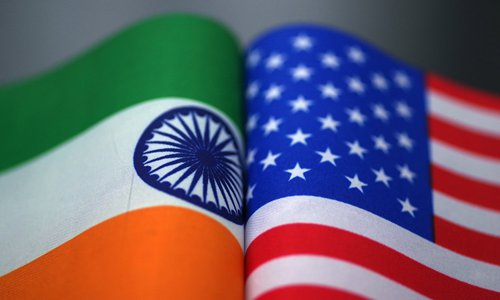HOME >> OPINION
India’s hiked tariffs show dissatisfaction with US
By Liu Xiaoxue Source:Global Times Published: 2019/6/19 18:03:40

Photo: IC
India increased tariffs on 28 US products, including almonds, apples, acids, and chemicals from June 16. How will this affect the US economy? How will US-India trade frictions influence bilateral ties?India's newly increased tariffs on American goods can be regarded as a response to US pressure on India's economy and trade. In March 2018, US President Donald Trump imposed a 25 percent tariff on steel and 10 percent tariff on aluminum goods imported from overseas, including India. On May 17, 2019, the US made a deal to remove the steel and aluminum tariffs on Mexico and Canada, but not on India.
It produced negative impacts on India's economy after the US imposed tariffs, with steel exports to the US dropping by 49 percent.
India proposed retaliatory duties against US tariffs on Indian steel and aluminum in 2018 but they were delayed being implemented, since New Delhi hoped to continue the negotiations with Washington and may have believed Washington would lift the steel and aluminum tariffs on New Delhi as well.
However, in 2019, Washington not only refused to exempt New Delhi from higher taxes on steel and aluminium imports, but also withdrew India's benefits under the Generalized System of Preferences (GSP).
Actually, the benefits under the GSP are not very important. New Delhi's exported goods to Washington, worth $5.6 billion under the GSP in 2018, were only about one tenth of the amount of products which India exported to the US ($54.4 billion in 2018).
Even India itself said the GSP withdrawal won't significantly influence exports to the US. New Delhi's increased tariffs on American exports aim to show its attitudes and dissatisfaction with unilateralism and trade protectionism of Washington.
Trump has criticized India's high tariffs on products such as motorcycles and whiskey. Generally speaking, the duties of India are high, but it is rational for a developing country.
Washington denies preferential treatment for developing countries, seeking absolute fairness, which runs counter to WTO provisions that allow other members to treat developing countries more favorably and shows US arbitrariness.
The joint statement of the Shanghai Cooperation Organization, which was signed on June 14, stated "They (member states) believe that unilateral protectionist actions in violation of WTO rules and regulations undermine the multilateral trade system and threaten the world economy and trade." As a member state of the organization, it reveals India sides with other developing countries such as China in maintaining multilateralism amid Washington's unilateralism and trade protectionism.
The US Indo-Pacific Strategy Report mentioned India over 40 times, showing the weight of India in the US Indo-Pacific strategy. Bilateral frictions in economy and trade are mainly due to issues such as the US trade deficit with India, and would not significantly influence their cooperation in geopolitics. Both countries will continue their cooperation in security and the bilateral ties won't be heavily influenced by trade conflicts.
Moreover, US-India trade frictions are limited and not as severe as China-US trade conflicts. The amount involved in the withdrawal of the GSP, US tariffs on India's exports, and India's retaliation is not big. For example, India's newly increased tariffs are only on $1.4 billion of American goods. The amount of US goods exported to India only made up 2 percent of total US exports in 2018.
Therefore, economically, the impact of New Delhi imposing duties on Washington is limited.
The author is an associate research fellow at the National Institute of International Strategy of the Chinese Academy of Social Sciences. opinion@globaltimes.com.cn
Posted in: VIEWPOINT